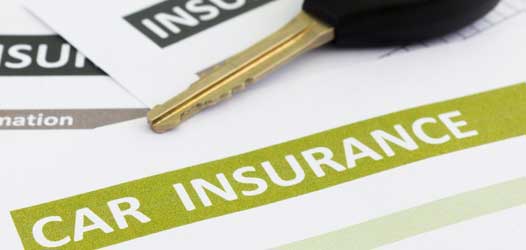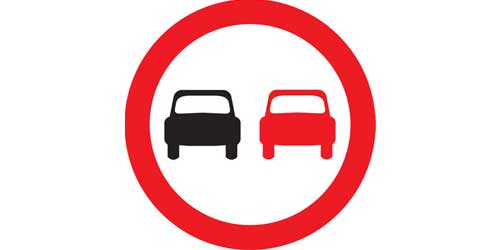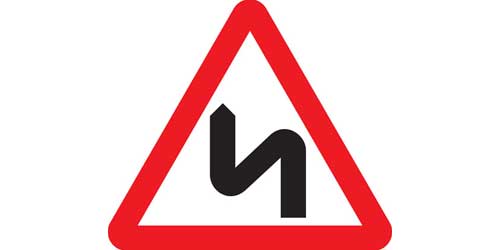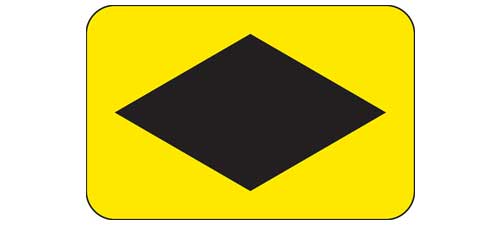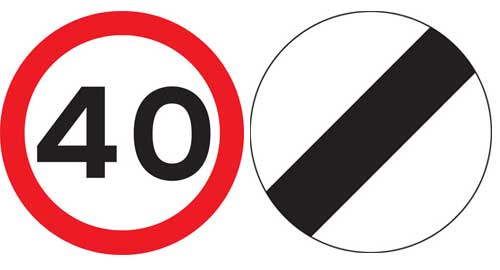This guide is designed to help drivers brush up on their knowledge of UK road laws and rules. Some of these will be pretty obvious but others will be more obscure, though we think it’s important for drivers to keep atop of all road laws and any updates on them.
In this guide we’ll look at the rules and regulations on:
Within each of these sections we’ll provide the information we believe all drivers should know around the legal requirements as well as general tips for good driving behaviours and safer journeys.
Documents Required to Drive
In order to legally drive in the UK you will need to have a number of documents that you / the vehicle hold.
The first document you will need is a driving licence. In order to drive alone you will require a full UK driving licence, and most companies will ask you to hold a full licence before they are able to offer you a company car.
If you only have a provisional licence then you will need to have a passenger in the front seat, who is in a capable condition and has held their licence for longer than three years who can advise and support you, including being alert to potential hazards and pointing these out.
Another aspect of licences you need to be aware of is that if you hold a driving licence for automatic transmission vehicles then you will not be able to drive a vehicle with a manual gearbox.
The second document you will need is the vehicle insurance document. If you are driving a company car then you might find that the company covers the insurance for you through a fleet policy, but you should always check if this is the case.
Legally all vehicles in the UK must have a minimum of third-party cover, though this is the most basic level of cover and will not cover any damage to your vehicle or injury to yourself or your passengers. Most drivers opt for a higher level of insurance that allows them additional cover for damage to their vehicle, medical support for injuries they receive and legal support.
Although the DVLA no longer issue physical road tax discs the police still have ANPR systems that will check whether your vehicle is taxed and penalise you if it is not.
Legally every vehicle must be taxed, unless it is parked on private land and you have notified the DVLA to advise it is SORN.
If you are driving a company vehicle then this will usually be covered by the business but as the driver we recommend checking this is the case to ensure you will not be penalised for driving an untaxed vehicle.
For drivers in personal leases, you should be aware that the road tax is covered by the lease funder for the duration of the contract. However, this is at the rate that it is charged when the vehicle is first taxed, and so if there is a rise in the vehicle tax you might be invoiced for the difference.
Another document that you no longer always get a physical copy of but is still required is the MOT pass certificate. This is a legal requirement for any vehicle over three years old, and you will need to ensure that your vehicle has this.
An MOT certificate is only valid for one year, and so your vehicle will need to be tested annually.
Items to Keep in the Car
In the UK there are not currently any laws that dictate you must keep essential items in the vehicle, or what they are. However, it is recommended that you keep a few key belongings like a warning triangle, high-vis jacket and water bottle in the vehicle.
If you plan on driving abroad then other countries in Europe do have legal requirements for items that must be kept in the car. For more information on this take a look here.
Road Signals and Signs
There are a number of different road signs and signals that you need to be aware of when driving in the UK.
We’ve got a detailed guide to UK road signs here but wanted to provide a brief explanation here too, as it is a requirement you follow these road signs.
Circular Signs
Circular signs give you orders that must legally be followed.
White signs with a red border around the edge will show an activity that you must not do. Blue signs will give an instruction that you must obey, for example, turn left ahead.
Speed limits are also shown in a circle. The majority of these will be a number within a red circle, this is a number you must not exceed.
Triangular Signs
Triangular signs give drivers a warning of potential upcoming danger.
These will usually be a white sign with a red border and a black image in the centre which indicates the hazard. Most signs will be a triangle pointing upwards, but there are a couple of exceptions to this like the give way sign which points downwards.
Rectangular Signs
Rectangular signs provide drivers with information. They are used to indicate:
- Distances to upcoming main roads and towns
- Bus and cycle lanes
- Vehicle restrictions in particular areas
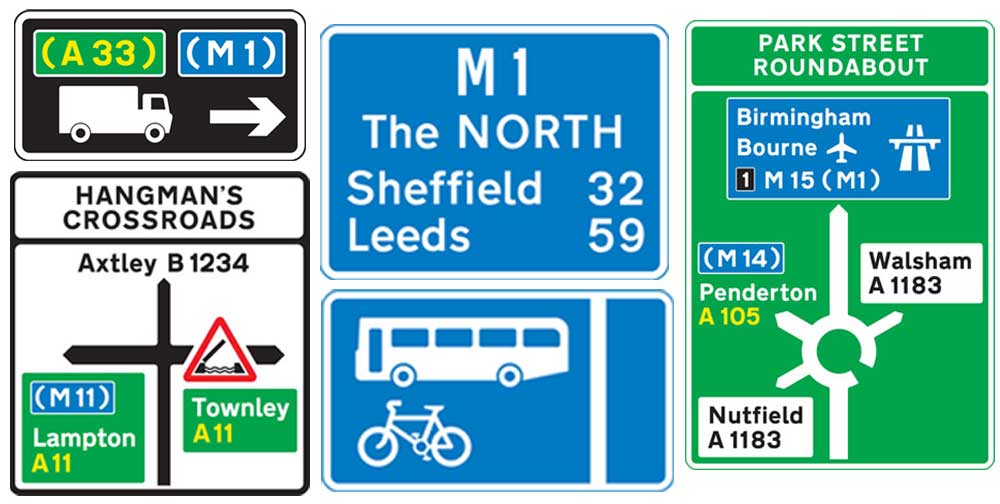
There are five colours of rectangular signs you will see: blue, green, white, black and yellow. In general blue signs are used on the motorway to provide drivers with information and also in built-up areas to indicate alternative vehicle routes, eg a bus lane, green signs are used on main roads that aren't a motorway and white signs are used on smaller roads. You will see black signs less frequently, and these are used to indicate the HGV route where the main route is unsuitable for them. Yellow signs are temporary ones and used for roadworks and diversion routes.
There are a few other signs that you will also need to obey which do not fit into these three categories, for example the hexagonal stop sign.
Lights and Signals
In the UK most traffic lights have three colours: red, amber and green.
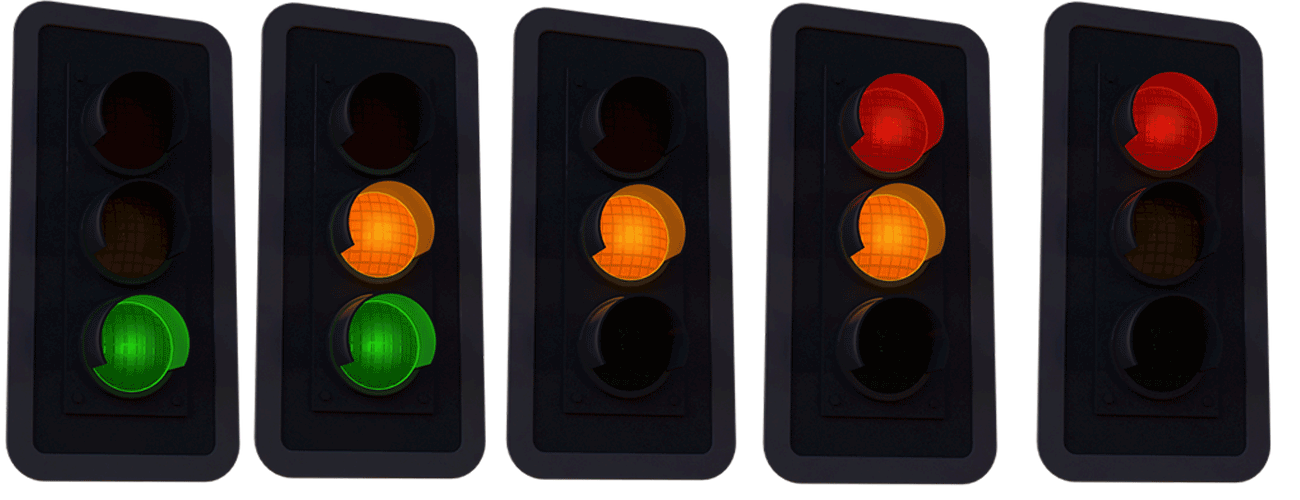
You must slow down and stop when an amber light is showing unless it would be unsafe for you to do so, and completely stop at a red light. On some occasions an amber light might show at the same time as a green or red light, as shown above, to indicate that the light is changing colour.
Additionally, some traffic lights might have directional arrows for turning traffic, a light for different vehicles like bicycles or buses or even different lanes for these vehicles. You should only follow the traffic lights if they apply to your vehicle and lane of traffic.
Traffic lights can be used at pedestrian crossings, junctions and roundabouts.
Another place you might find lights is at a railroad crossing. This will not have the standard traffic lights but a rectangular sign with three flashing lights in a triangle formation. The top two will usually be red and the bottom one will be amber. When these are flashing and the barrier is coming down across the road you must stop as this signals an approaching train.
When you are learning to drive you will be taught about road signs and signals that you will encounter but it doesn’t hurt to refresh your knowledge and you can find these in the highway code.
General Road Laws
Road laws in the UK cover every aspect of driving, road and vehicle usage which is why there’s so many of them. We’ve got more detailed sections below but before we get into specific areas we wanted to give a quick overview of some of the key laws you should be aware of.
Please note this is not a comprehensive guide to every UK road law but a general overview of them.
Some key laws you should be aware of are:
- Drive on the left side of the road
- Obey all road signs and light signals
- Seatbelts must be worn by all drivers and passengers unless they have an exemption
- All children in the car must be in an appropriate car seat until they reach 12 years old or 135 cm tall and the driver will be responsible for ensuring they are in the correct car seat, and until they are 14 years old they are wearing an appropriate belt
- Give way to all emergency vehicles but continue to obey traffic lights and signals when doing so
- Obey the pedestrian crossing rules
- Don’t use your mobile phone or other mobile devices when driving
Driving Laws for Drivers with a Medical Condition
If you have a medical condition then you might need to notify the DVLA of this, whether you believe it affects your driving or not, as they can have an impact without you realising it.
The conditions that you need to notify the DVLA of includes many that you might not expect, including:
- Acoustic neuroma (sudden and disabling dizziness)
- AIDS
- Alcohol problem
- Alzheimer’s disease
- Amputation
- Angina
- Angiomas or cavernomas
- Aortic aneurysm (larger than 6cm)
- Arachnoid cyst
- Arteriovenous malformation
- Ataxia
- A defibrillator device
- Bipolar disorder
- Blepharospasm
- Blood clot in the brain or having had a burr hole surgery to remove one from around the brain
- Brachial plexus injury
- Brain abscess, cyst or encephalitis
- Brain aneurysm
- Brain empyema
- Brain haemorrhage
- Brain tumour
- Brugada syndrome
- Cataplexy
- Central venous thrombosis (for over a month)
- Cerebral palsy
- Cognitive problems
- Déjà vu caused by seizures or epilepsy
- Dementia
- Diplopia (double vision)
- Epileptic seizures and blackouts
- Fits, seizures or convulsions
- Guillain Barré syndrome
- Heart attack (myocardial infarction) or a heart, cardiac or coronary angioplasty
- Heart palpitations
- Huntington's disease (if causes any symptoms)
- Hydrocephalus
- Hypoglycaemia
- Hypoxic brain damage
- Korsakoff's syndrome
- Labyrinthitis (when symptoms last for over three months)
- A learning disability
- Lewy body dementia
- Limb disability
- Long QT syndrome
- Marfan's syndrome
- Medulloblastoma
- Motor neurone disease
- Multiple sclerosis
- Muscular dystrophy
- Myasthenia gravis
- Myoclonus
- Narcolepsy
- Nyctalopia (night blindness)
- Optic atrophy
- Optic neuritis
- Obstructive sleep apnoea syndrome (OSAS), with excessive sleepiness
- A pacemaker
- Paranoid schizophrenia
- Paraplegia
- Parkinson’s disease
- Peripheral neuropathy
- Pituitary tumour
- Psychosis
- Psychotic depression
- Pulmonary arterial hypertension
- Schizo-affective disorder
- Schizophrenia
- Scotoma
- Serious head injury
- Severe memory problems
- Spinal condition or an injury to your spine
- Subarachnoid haemorrhage
- Traumatic brain injury
- Transient ischaemic attack (mini-stroke)
- Tunnel vision
- Usher syndrome
- VP shunts
- Wolff-Parkinson-White syndrome
This is not an extensive list and there are additional illnesses that you will need to notify the DVLA of if they affect your driving or meets a particular set of conditions as defined by the DVLA. These include conditions like agoraphobia, eating disorders, PTSD, cancer and ADHD.
To find out if a medical condition needs reporting to the DVLA you can speak to your doctor or check the government’s list here.
If you have had surgery or a broken limb and this prevents you from driving for more than three months you will need to let the DVLA know of the injury and your expected time off the road.
You will also need to let them know of any eyesight condition that prevents you from passing a standard eyesight test.
Another thing you will need to notify them of which you might not expect is if you have ever misused prescription drugs or used illegal drugs.
Some conditions might only be temporary, and you can notify the DVLA of any change in your condition to apply to have driving restrictions lifted.
If you have a reportable condition and have not notified the DVLA then you could be fined up to £1,000 if you’re involved in an accident.
You should also make your insurance provider aware of any medical condition that you needed to notify the DVLA of. If you have a company vehicle that is on a business fleet policy then you can speak to your HR team and the fleet manager in order to ensure this is handled correctly.
Laws on Speed
One of the areas that a lot of drivers get caught out by the law is speeding.
There are a number of laws on speed in the UK as every road has a speed limit that must be obeyed and if you go over this, even by just one mph, then you can be penalised.
The speed limit will usually be shown, as mentioned above, on a white circular sign with the maximum speed in black and a red outline on the sign. This will be shown at the point where a speed limit changes and on main roads you will usually see smaller reminder signs as well.
Another speed limit sign you might see is the national speed limit one shown on the right.
The limit this applies will vary depending on the type of road you are travelling on and the lanes of traffic this road has. In a built-up area it will be 30 mph, though it is rare to see one here, on a single carriageway road in a non-built up area it will be 60 mph and on a dual carriageway or motorway it is 70 mph.
These limits are for a standard vehicle and you should be aware that there are some vehicles that have their speed limited to a lower limit. For example, those towing are not legally allowed to travel at 70 mph.
It’s also important to note that this are maximum limits and not a target, sometimes the speed limit is not safely achievable as road condition, weather and other road users might restrict your speed.
Though it’s rarer you might also encounter a minimum speed limit in places such as a long tunnel where a slow moving vehicle could be hazardous for itself and other road users.
A minimum speed limit will be signposted differently, with white numbers on a blue background, as pictured below. For the end of the minimum limit this sign will have a red line through it like the version on the right, below.
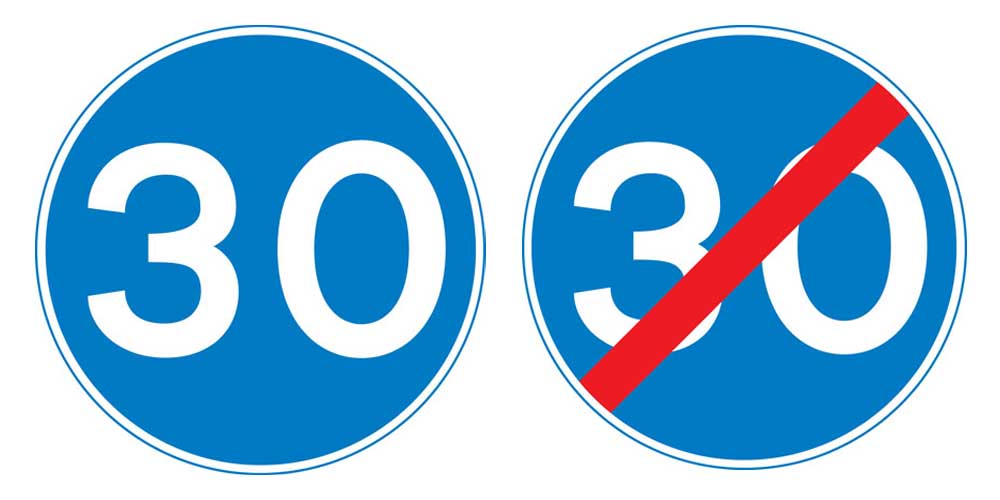
Speeding
Vehicles can obviously travel faster than the maximum speed limit, and this is especially true on roads with lower limits, which means that many drivers have been caught speeding.
If you go even one mph over the limit then you are technically speeding and can be legally held accountable and penalised for this.
The National Police Chiefs Council (NPCC) advises of a 10% plus 2 miles guideline, however this is just a guideline and police can use their discretion so we recommend not going over the speed limit at all.
If you are caught speeding then the penalty you receive will depend on how quickly you are driving but in general the minimum penalty you will receive is a £100 fine and three points on your driving licence.
For minor speeding offences, the police may offer you a speed awareness course instead depending on the availability, how fast you were travelling and whether you have been on a speed awareness course previously.
You will have to admit to driving the speeding vehicle in order to be accepted on the course and you will be responsible for paying this yourself, at an average cost of between £80 and £100, and completed within 12 weeks of the offence.
For serious speeding offences you might instead get a courts summons or you might choose not to accept the fixed penalty fine and challenge this in court instead. You might choose to challenge the penalty if the speed camera has not recently been calibrated, if road signs were obscured, you can prove you weren’t driving or there are details missing on the ticket.
In the event that you end up in court for a speeding offence then they will follow pre-set sentencing guidelines which fall into three bands: A, B and C. These penalty bands will depend on the specific offence and any mitigating circumstances that might apply but in general will fall into the categories shown below:
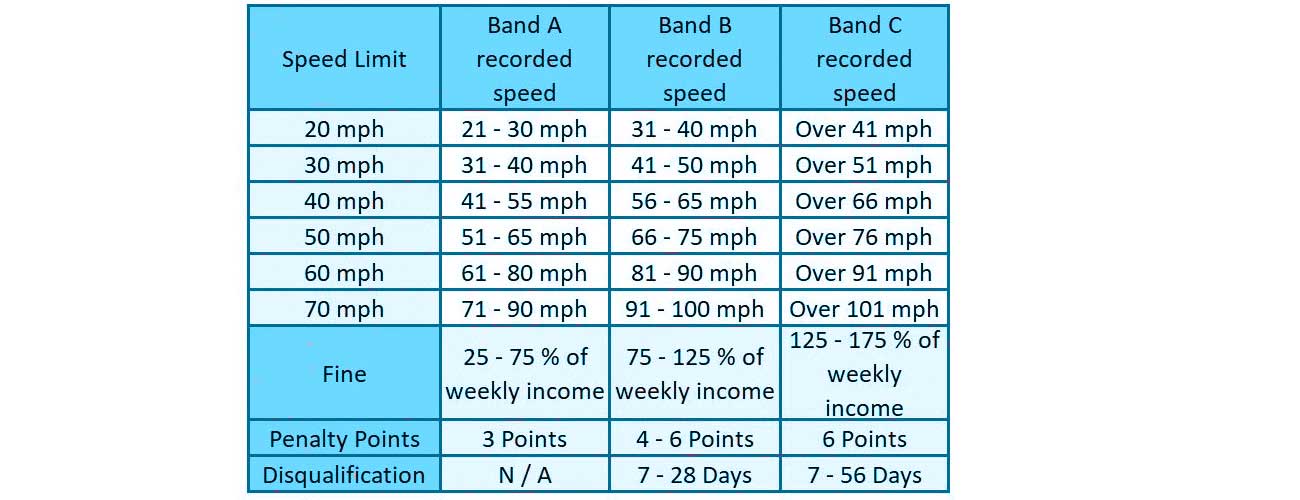
If you are speeding in poor weather, near a school, highly pedestrianised area, in heavy traffic, while towing, have passengers, are in a lorry, bus or taxi you are likely to receive a higher penalty. You’re also more likely to receive a heavier penalty if you have previous speeding or driving offences.
The court will also take into account mitigating circumstances for example if you had a genuine emergency, if you have a clean driving record, show clear remorse and have a good character.
If you receive a speeding offence you will need to notify your insurance provider and this could lead to changes in your insurance premiums.
Slow Driving
Although speeding is the main offence you see drivers receive in relation to speed, you can also be penalised for driving too slowly.
Driving too slowly can be classed as driving without due care and attention if your driving is deemed a risk that endangers others. This can give you a fine of £100 and three points on your licence, which can rise to a £500 fine and nine points on your licence if you take it to court.
There are also a few places where a minimum speed limit applies. This will be used in places where it could be harmful for you and others around you to be travelling at slow speed. Once place you will usually see minimum limits is in a long tunnel as travelling too slowly can build up harmful emissions in an enclosed space.
The sign on the left shows what you will see at the start of a minimum speed limit and the sign on the right shows what you will see at the end.
Laws on Parking Your Vehicle
When you’re not driving your vehicle will be parked, and there are a number of laws that cover parked vehicles rather than moving ones.
In this section we’re going to look at two main areas; where you can park and parking at night.
Where to Park
In the UK there are a number of different locations you can park, including:
- Designated car parks
- Parking bays or lanes on the side of the road
- On the road where no restrictions apply and your vehicle does not cause a hazard to other road users
- On the pavement where no restrictions apply and you are not causing a hazard for others
- On verges where no restrictions apply and you are not causing a hazard for others
- Driveway or alternative off road parking on private property
When parking there are a few general rules you should obey. These are not all legal requirements but some are and others are considered to be good practice.
- Use a designated bay where possible
- Park inside the lines
- If parking on the road try to park as close to the pavement as possible
- If parking on the road don’t face oncoming traffic
- Obey any road signs advising of parking time or vehicle size restrictions
- Do not park in a disabled bay without a valid blue permit
- Do not park in a parent and child bay unless you have young children
- Do not park in a loading bay unless you are loading / unloading
- Do not park on a corner, turn or at a junction where you are blocking visibility at a crucial point
- Do not block a drive entrance or dropped curb outside a property that blocks another vehicle’s exit
Pavement Parking
On the whole, it is acceptable to park slightly on the pavement, provided you do not totally block the way of pedestrians, to minimise the obstacle you are to oncoming traffic.
However, there are a few exceptions. It is illegal to park on any pavement in London and you will receive a fine of up to £70 if you are found parked on the footpath. London is the only city that expressly forbids parking on any of its pavements at the minute. There are places in other city and town centres where parking restrictions or no parking zones apply and you will be fined if you park in these.
Night Time Parking
There are also slightly different rules on parking at night and this is because darkness reduces visibility for all drivers.
Rule 248 of the Highway Code states that you must not park on the side of the road facing against the direction of the traffic, unless in a recognised parking space.
This is because your vehicle will not be as easy for oncoming drivers to see because they will not see the rear reflectors, and so your car is more of a hazard for other road users.
You could receive a fine of up to £1,000 in a car or small vehicle but a goods vehicle or one with over eight seats can receive a higher fine of £2,500.
Encountering Other Road Users
Though most of us drive cars there will be other road users that you should be aware of when driving.
There will be larger vehicles like lorries, buses and tractors who may not be able to achieve the same speed as you, will have a wider turning circle and larger blind spots. You will need to be aware of these differences and make accommodations for them, for example at a roundabout if you are in the lane next to a lorry you should be prepared to give them extra room.
There will also be smaller road users like pedestrians, cyclists and horse riders who you will again need to be aware of the different ways in which they use the road and the accommodations you should make for them.
When passing pedestrians, cyclists or horse riders you should always allow plenty of room when passing and slow down so that you do not startle them or create an accident with high speed side wind that could knock them down.
If you are passing someone with an animal we also advise turning down your radio, though this is not a legal requirement, as this reduces the risk of spooking the animal.
Pedestrians should only be using the road where there is no footpath for them to drive on, however you should also be mindful of pedestrians on paths that run alongside a road. This is particularly true on a wet day where splashing a pedestrian by driving too fast through surface water can lead to a £100 fine and three penalty points for you. This is because it is classed as an offence under section three of the Road Traffic Act 1988 as you would be classed as driving without reasonable consideration for other persons.
Legally cyclists should be using the road and not a footpath unless it is part of a cycle path route or a bridleway.
They also have the same rights as any other road user, including cars, and so can use the full width of the road, and many will sit slightly further out than you might expect to avoid drains and potholes. They can also come across for turning, and cycle two abreast where there is a less confident rider. This applies to all ages of cyclists so children can be riding on the road. With this in mind, it’s especially important that you ensure there is plenty of space and time for you to safely pass them.
Some roads will also have a cycle lane and it is an office to drive in one that is marked by a solid white line for which you can be fined up to £130.
There are laws and regulations for all road users, including all of the ones mentioned above, however as you will typically be the one in charge of the faster or larger vehicle you will be the one who is usually expected to make accommodations.
Not every road user is aware of, or always follows, the laws dictating the interactions between different types of road users. So, you should not expect others to behave in the way you would or they should.
UK Towing Laws
In the UK vehicles that are towing another vehicle, caravan or trailer are restricted to lower speed limits. This will usually be 10 mph below national speed limits so 50 mph on single carriage outside of built-up areas and 60 mph on dual carriageways and motorways.
Another restriction placed on towing vehicles is that they cannot use the far right lane on a motorway, if there are three or more lanes of traffic, and doing so can result in a fine of £2,500 and three points on your licence.
Legal Vehicle Maintenance Requirements
We mentioned above that it is a legal requirement for your vehicle to have a valid MOT. If you are found driving a car without one then you can be fined £1,000. It will then be taken to have an MOT completed and if it fails and is deemed dangerous due to the faults then this fine can increase to £2,500 and you can receive three points on your licence or even be banned from driving.
You are also required to keep your vehicle in a roadworthy condition, and this means fixing any dangerous faults as quickly as you are able to, keeping up with the servicing schedule to ensure any regular maintenance work is completed as well as any additional faults spotted and repaired as quickly as possible.
Laws on Road Accidents in the UK
We’ve got another guide that specifically looks at what to do if you’re involved in a road traffic accident which will provide you with lots of useful tips. However, there are three legal points that you must be aware of if you are involved in an accident.
The first is that you are required to stop, even if you hit a parked vehicle or road furniture like a fence.
You must also provide your insurance and contact details to any third party that is also involved in the incident or whose property is.
The final thing you are legally obligated to do is to notify the police.
Police must be informed of any accident within 24 hours of it happening. Depending on the severity of the accident and the circumstances of it then you don’t always need to do this at the scene. If it is not an emergency and the road is not blocked then you can call them on 101, otherwise you should call 999.
General Driving Etiquette
There are a few more obscure laws and rules that you might not already know but probably should.
For a full breakdown of all the rules you can check the Highway Code here but we’ve rounded up the ones we think you need to know below.
Many drivers can experience road rage, and although they might not get out or their car or drive aggressively to release their frustration they may swear at other drivers.
However, if you are particularly aggressive then you can be fined up to £1,000 for road rage and swearing at other road users under the Crime and Disorder Act of 1998.
Another activity that you might not know can get you into trouble is turning up the volume. If your music is considered to be so loud it could be a distraction to you whilst driving then you can receive a fine of £100 and three points on your licence. And if you’re asked to turn down the music by police and refuse to do so then they can seize your vehicle.
Rule 112 of the Highway Code states that you should never sound your horn aggressively, you must not use your horn while stationary on the road or when driving in a built-up area between 11.30 pm and 7 am except when a road user poses a danger. If you are caught using your horn inappropriately then you might be fined up to £1,000.
If your vehicle is stopped by the police over concerns about your driving and you are found to be eating or drinking a non-alcoholic that they believe has distracted you from concentrating on the road, you can be fined £100 and receive three points on your driving licence under careless driving.
Tailgating is a term used to describe driving very closely to the vehicle in front of you. This can be very dangerous, particularly if there are poor road or weather conditions, or the vehicle in front of you suddenly brakes. If you are caught tailgating then you might be charged with careless driving and receive a fine and three points on your licence.
It’s well known by most drivers that unless you are overtaking then you should be in the left-hand lane of traffic on a multi carriageway road. This isn’t just considerate road behaviour it’s actually a law that you should move left unless overtaking. If you are caught unnecessarily staying in the middle lane when there is space on the left then you can be charged with careless driving and be fined and get three points on your driving licence.
Though it seems like a considerate thing to do you should not warn approaching motorists of any speed traps that they are approaching. Doing so could be considered to be “wilfully obstructing a constable in the execution of their duty” which you can receive a £1,000 fine.
When an emergency vehicle is approaching you on the road you should move out of the way in order to allow them to get to their destination as quickly as possible. However, you should not break any other road laws in order to do so, for example going into an active bus lane or through a red traffic light. Despite the approaching emergency vehicle this is still considered breaking the law and you could be penalised for it.
Rule 229 of the Highway Code states that you must demist your windows making sure they’re all clear, clean all your mirrors, clean your lights, and ensure your number plates are visible.
If it has been snowing and there’s snow on your vehicle then you will need to clear this off. In particular, you are required to clean the snow from your roof as if this falls it will either be a hazard to you by obscuring your windscreen or for other users by flying off.
Driving with snow on your roof could lead to you being stopped and charged with driving without due consideration or using a motor vehicle in a dangerous condition which comes with a fine and the possibility of three points on your licence.
This is another obscure one that not a lot of drivers know or are charged with but if you’re idling with your engine running unnecessarily then you could be fined. Under section 42 of the Road Traffic Act 1988 and Rule 123 of the Highway Code you should not leave your engine running unnecessarily while stationary on a public road.
This is only on public roads, and not private ones, and does not include if you are stuck in traffic.
If caught then you could be fined £20, or in certain parts of London up to £80.
Pets in the Car
There are times when you need to transport your pet in your car, whether it’s to get to a new walk location or a visit to the vets.
Currently, there are no laws that specifically address animals in the vehicle, but it is strongly recommended that all pets are properly restrained when travelling in order to prevent them from becoming a distraction for the driver.
Although there are no specific laws relating to pets in the car you could be charged with driving without due care if you are stopped by the police because they believe that you are distracted whilst driving and this is found to be because of an animal in the vehicle. This comes with a fine of up to £5,000 and nine points on your licence if your case is severe enough to be taken to court.
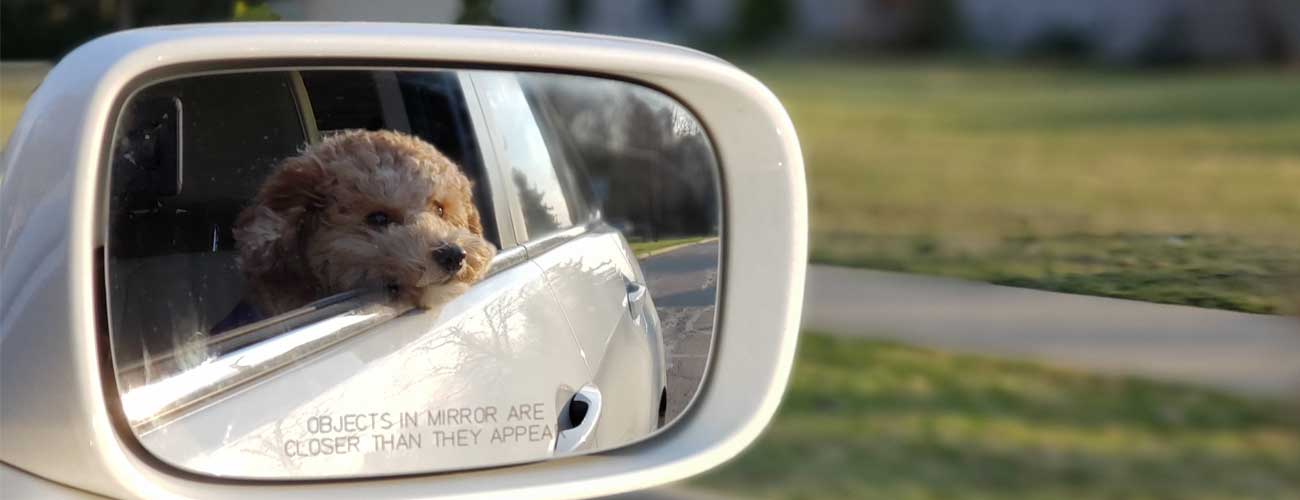
Your Road Safety Questions Answered
We know that the above is a lot to take in so we've answered some of the most common questions below!
Is It Illegal to Drive a Vehicle That's in a Dangerous Condition?
Under Section 40A of the Road Traffic Act 1988 it is illegal to use, or allow someone else to use, a motor vehicle or trailer on a road when it is in a condition that will pose a danger of injury to any person, including those inside the vehicle. As well as the condition of the vehicle you can also be found to be breaking the law if its accessories or equipment are in poor condition, the number of passengers, the weight or distribution of the load are a danger to injury of any person.
If you are aware of any faults with your vehicle you should get these repaired as quickly as possible to avoid driving a dangerous vehicle.
What is the Penalty for Hit and Run on a Parked Car?
You must always notify the police if you are involved in an accident, no matter the severity of it. If you are not blocking the road and there is not need to call the police to the scene you can call them on 101 within 24 hours of the inccident.
If you do hit a parked vehicle you should get out at a safe location and if you are unable to locate the owner of the vehicle then you should leave a note for them with your contact details as well as make some notes of the damage and vehicle details for your own records.
If you do not notify the police and leave the scene without stopping then you face up to 10 points on your driving licence, up to £5,000 fine and a prison sentence of up to six months.
Is It Illegal to Leave Your Car Running in Your Driveway?
Under the Highway Code it is illegal to leave your car unnecessarily idling, however there are some exceptions to this including if you are parked on a private driveway.
We would still advise trying to avoid leaving your vehicle idling as it continues to use fuel which reduces your fuel economy and continues to pollute the air around you.
Is It Legal to Sleep in Your Car?
Yes, you can legally sleep in your car provided you are parked in a safe and legal location.
However, if you have been drinking or have consumed illicit drugs you should never sleep in your vehicle as you can be charged with being intoxicated and in control of a motor vehicle, even if you are not in the driver's seat or holding the keys. This comes with a fine and 10 penalty points on your licence, which is over the maximum amount allowed.
Can I Refuse to Drive a Company Vehicle?
Yes, you can refuse to drive a company vehicle.
The first reason you might choose to reject a company car is that the perk does not work to your benefit if you have an existing vehicle or the BIK tax works against you.
The second reason you might refuse a company car is that it is unsafe to drive. If a vehicle is not in a roadworthy condition and you are driving it then you will be the one who will face penalties such as a fine and driving licence points.
For more guides on staying safe whilst on the roads click here or if you'd like to learn about driver training and how your company can support you with this then take a look at this guide.

